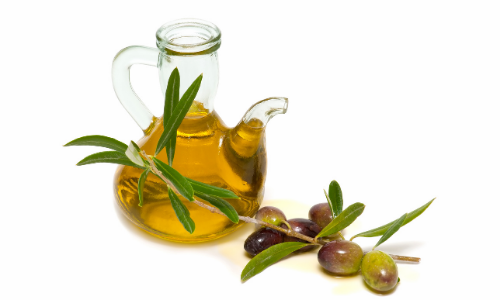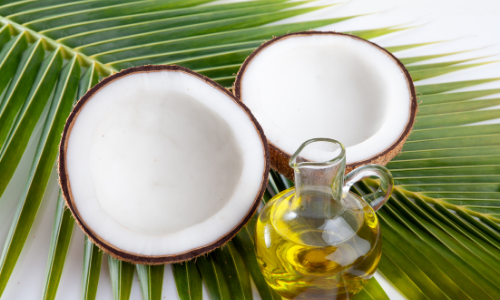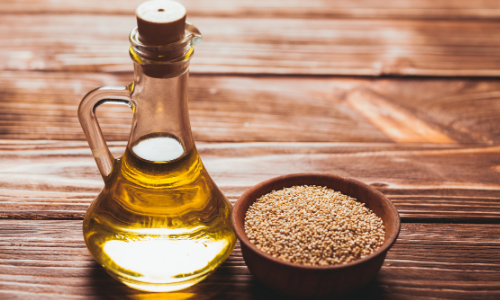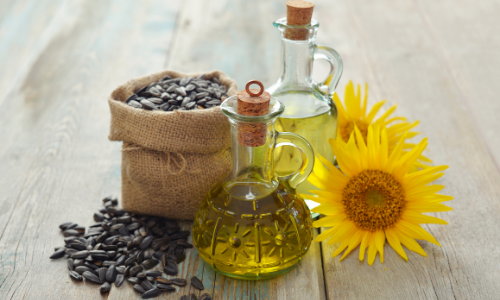Cooking oils are a staple in every kitchen. With so many options available on the shelves of your local grocery store – how do we know which one is healthy for us? How do we choose the right oil?
This mainly depends upon the kind of cooking you are doing. You need to assess the needs of your recipe and the smoke point of the oil. The smoke point or the burning point of an oil is the most important factor to consider. Any oil heated beyond its smoke point undergoes oxidation and forms free radicals and other harmful substances that you shouldn’t be eating.
Different oils have different characteristics, which make them better for certain uses. Some oils are great for frying, some are ideal only for drizzling or used as a garnish, while others are more suited for high-temperature cooking.
The healthiest cooking oils are those which contain more good fats and less saturated fats. Here we have put together the five healthiest oils you can start cooking with.
1. Olive Oil

Olive oil is made from crushing olives and hailed as the healthiest of plant oils. It has long been believed to boost longevity, aid in weight loss, and reduce the incidence of getting diseases. Most nutrition and cooking experts consider olive oil the most healthy and versatile oils to cook with. There are different varieties of olive oil to choose from.
Extra virgin olive oil
Extra virgin olive oil is unrefined olive oil derived from the first press of olives and has a full-bodied flavor. This is the highest quality olive oil you can buy. It is not treated with chemicals or altered by temperatures. It has a golden-green color and a distinct flavor. It retains the more natural taste of the olives and contains more vitamins and minerals found in olives.
Extra virgin olive oil has relatively more polyphenols than regular olive oil. Polyphenols are a type of antioxidants and are known for their many health benefits. Refining olive oil can make it lose its polyphenols, vitamins, other natural substances.
Extra virgin olive oil can be a great addition to salad dressings, marinades, bread dippings, and pasta because of its deep peppery flavor. Due to its low smoke point, extra virgin olive oil is not suitable for cooking at high temperatures (smoking point- 325 to 375 degrees Fahrenheit) such as when frying or roasting.
Virgin olive oil
Virgin olive oil is also an unrefined form of olive oil. Although it is not as high quality as extra virgin olive oil but can add flavor and depth to any dish. Virgin olive oil is also derived from the first pressing but is slightly lower in quality, lower chemical standards, and higher levels of fatty acids than extra virgin olive oil. This oil has a little higher level of oleic acid, i.e. 2 %.
It has a milder taste and is most suitable for low heat cooking purposes, such as sauteing or making sauces, and not for deep frying.
Pure olive oil
Pure olive oil is a mix of virgin olive oil and processed oils. Processing oil allows the oil to last longer and allows it to be heated at high temperatures, making it suitable for cooking.
Pure olive oil is derived from the second pressing of olives using heat and other chemical treatments. It contains 10 % virgin olive oil and the oleic acid level also varies from about 3 to 4 %. Even some virgin olive oils are blended too.
Light olive oil
Light olive oil is derived from black and ripe olives. This oil is only good for cooking purposes involving high temperatures. Light olive oil does not mean that this oil has a few calories or low-fat content, but light refers to the light color and neutral flavor. Instead of a deep green color, light olive oil has a golden yellow color. This oil is often blended with vegetable oils and contains less than 10 % virgin olive oil. It is derived using heat after the first pressing of the virgin oil. Light olive oil can be used for grilling, frying, baking, and sauteing.
Olive pomace oil
Olive pomace oil is the lowest grade olive oil extracted from the residue after the olive fruits have been pressed. Virgin olive oil is added to it to improve its quality. Due to this reason, olive pomace oil is the least expensive and appropriate for high heat cooking.
Benefits
- As per some studies, extra virgin olive oil can help prevent cancer and type 2 diabetes.
- Olive oil is rich in antioxidants, which can help protect the body from cellular damage.
- It may reduce the chances or risks of developing cardiovascular diseases.
- Olive oil is 100% fat, and around 75% of this fat is monounsaturated that is linked with various health benefits.
- Research shows that oleic acid found in olive oil has anti-inflammatory properties and plays a crucial role in reducing inflammation.
2. Coconut Oil

Coconut oil is uncommon in the Western world and is touted as a superfood. It is popular among several populations around the world, especially in Southeast Asian countries, and is a dietary staple. Coconut oil boasts of a unique combination of fatty acids that have a positive effect on your health. It can help in fat loss, improve health, and brain function.
If you are using coconut oil for cooking, you should know which oil is best to use. The fatty and creamy quality of coconut oil makes it a great vegan butter or lard alternative for baked goods.
There are two types of coconut oil – virgin and refined coconut oil.
Virgin coconut oil
Virgin coconut oil is cold-pressed and is extracted without the use of any solvents. The smoking point of virgin coconut oil is 350 degrees Fahrenheit and is suitable for baking and sauteing. So, if you use coconut oil instead of butter in baked goods, you would use approximately 25% less coconut oil than the amount called for butter since coconut oil has a higher percentage of fats in it.
Refined coconut oil
Refined coconut oil involves the use of additives and is processed. It has a smoking point of 400 degrees Fahrenheit, making it best for frying and cooking at higher temperatures.
Coconut oil is solid at room temperature because of its high content of saturated fat. So, if you want to use it to grease baking pans, you can buy it in spray form.
Benefits
- The healthy fatty acids in coconut oil can stimulate your body to burn fat and also provide instant energy to your brain and body.
- Virgin coconut oil is full of antioxidants and has anti-inflammatory properties.
- Coconut oil can keep illness-causing bacterias and viruses at bay.
- It is also a source of medium-chain triglycerides.
- Unlike other plant-based oils, coconut oil is primarily a concentrated source of saturated fat. Coconut oil is 90% saturated fat and saturated fat is associated with spiking bad cholesterol, which can clog arteries and lead to cardiovascular diseases. Although, research on coconut oil is inconsistent, with some studies showing it to raise good HDL cholesterol. However, coconut oil shouldn’t be relied upon as the main source of fat in your diet and is best consumed in moderation.
3. Sesame Oil

Sesame oil is an edible vegetable oil derived from raw pressed sesame seeds. It is used both as a cooking oil and a flavor enhancer. Sesame oil is low in saturated fats and rich in monounsaturated and polyunsaturated fats. There are different types of sesame oils available for use.
Cold-pressed untoasted sesame oil
Cold-pressed sesame oil is extracted from the seeds without using any heat and is usually considered the best kind of sesame oil to use. It has a paler color and milder flavor and has a smoking point of 350 degrees Fahrenheit. Due to this reason, it is unsuitable for frying.
Untoasted sesame oil has a high concentration of Vitamin E, and unsaturated fatty acids. It makes an excellent base for mayonnaise, cold sauces, and dressings.
The refined untoasted sesame oil has a high smoke point and is used as cooking oil for vegetables and meats. It adds a subtle sesame flavor and nuttiness to the food.
Toasted sesame oil
Toasted sesame oil involves roasting the seeds first, then being cold-pressed to extract the oil. It is just a bit more flavorful and a super alternative to peanut oil if you have a peanut allergy.
This sesame oil is thicker in consistency, has a more distinct flavor, and is darker in color. Toasted sesame oil can add depth to steamed vegetables, bring warm notes to vinaigrettes and salads. It can be drizzled over noodle soups, stir-fries, fried rice and tastes wonderful in Asian sauces and salad dressings. Toasted sesame oil should not be used for frying, as heating will give it a burnt and bitter taste.
Benefits
- Sesame oil is rich in monounsaturated fats, and research shows that unsaturated fats are good for heart health.
- It is also believed to regulate blood sugar levels.
- It can add an amazing flavor to your food.
- Cold-pressed sesame oil is high in Vitamin E that gives sesame oil its antioxidant property.
4. Sunflower Oil

Sunflower oil is extracted by pressing the seeds of the sunflower plant and is full of heart-healthy poly and monounsaturated fats. It has a smoke point of 450 degrees Fahrenheit and a slightly nutty flavor.
There are different varieties of sunflower oils available for cooking, and they all vary in their balance of monounsaturated and polyunsaturated fats.
Cold-pressed sunflower oil
Cold-pressed sunflower oil is unrefined, has a rich, nutty flavor, and can be used in salad dressings and making sauces.
High-oleic sunflower oil
High-oleic sunflower oil is considered healthy due to its lower content of Omega- 6 fatty acids and higher content of Omega 3s as compared to other types of sunflower oils. High oleic oils contain more monounsaturated fat or oleic (approx 80%). This type of sunflower oil has added stability and a neutral taste profile. It is slightly expensive but has long shelf stability and does not require hydrogenation. This is an ideal oil for baking, frying, and other high heat applications.
Mid-oleic sunflower oil
Mid-oleic sunflower oil falls somewhere between high oleic oil and linoleic oil. It can be used in salads and for stir-frying. This type of sunflower oil is considered the standard sunflower oil in North America. Mid-oleic sunflower oil has low saturated fat levels and is stable without hydrogenation.
Linoleic sunflower oil
Linoleic sunflower oil mainly consists of Omega-6 fatty acids and lacks Omega-3s. This could unbalance the ratio of Omega 3 and 6 fatty acids in your diet. Linoleic sunflower oil needs hydrogenation to be stable for frying. If using linoleic sunflower oil, try to add fish or other Omega-3 rich foods to your diet.
High linoleic sunflower oil is deemed to be the most unhealthy type of sunflower oil, in comparison to the high oleic oil which contains more healthy fats.
Benefits
- Sunflower oil contains omega-6 fatty acids in high quantities.
- It has a lot of Vitamin E, a powerful antioxidant that is known to boost your immune system and is indispensable for the health of your cells and tissues.
- Studies show that phytochemicals such as choline and phenolic acid contained in sunflower oil are beneficial for heart health. Sunflower oil is free from trans fats that are known to heighten the risk of developing heart disease.
- As per some research, sunflower oil can also lower LDL cholesterol or bad cholesterol.
- Sunflower oil is extremely light in taste and appearance and also acts as a mild laxative that can help in constipation.
- It contains monounsaturated and polyunsaturated fats with low saturated fat levels.
- It is also a good source of linoleic acid, an essential fatty acid that our bodies can’t make ourselves and which we need to get from food.
5. Peanut Oil

Peanut oil is derived from the seeds of the peanut plant. It can have different types of flavors depending on its processing. Its taste could vary from mild to strong and nutty. Due to its high smoking point (437 degrees Fahrenheit), peanut oil is ideal for frying and high heat cooking.
Refined peanut oil
Refined peanut oil is bleached, refined, and deodorized. It has the allergenic parts removed and is safe for those with peanut allergies. Refined peanut oil is commonly used by restaurants for frying foods such as French fries and chicken.
Cold-pressed peanut oil
Cold-pressed peanut oil is derived by crushing the peanuts and taking out their oil. This technique retains more nutrients and the natural peanut flavor as compared to the refined one.
Gourmet peanut oil
Gourmet peanut oil can be roasted to provide a wonderful peanut flavor and aroma. This oil is not refined and is deemed specialty oil. It also gives huge amounts of Vitamin E and phytosterols.
Peanut oil blends
Peanut oil is also blended with cheaper oils such as soybean to make it more affordable for buyers.
Benefits
- Peanut oil is healthy for the heart as it is high in monounsaturated fat.
- Research shows that peanut oil can reduce your bad cholesterol or LDL. This can curtail the risk of developing cardiovascular diseases or having a stroke.
- Peanut oil is a wonderful source of Vitamin E, an antioxidant that helps maintain your metabolism and immune system.
- Refined peanut oil is perfect for healthier frying.
The Takeaway
Ensuring you are using the ideal oil for whatever cooking method you choose is important to staying within the smoking point limit and to improve the quality of your food.
So, choose the right oil for yourself for a fitter and finer tomorrow!


